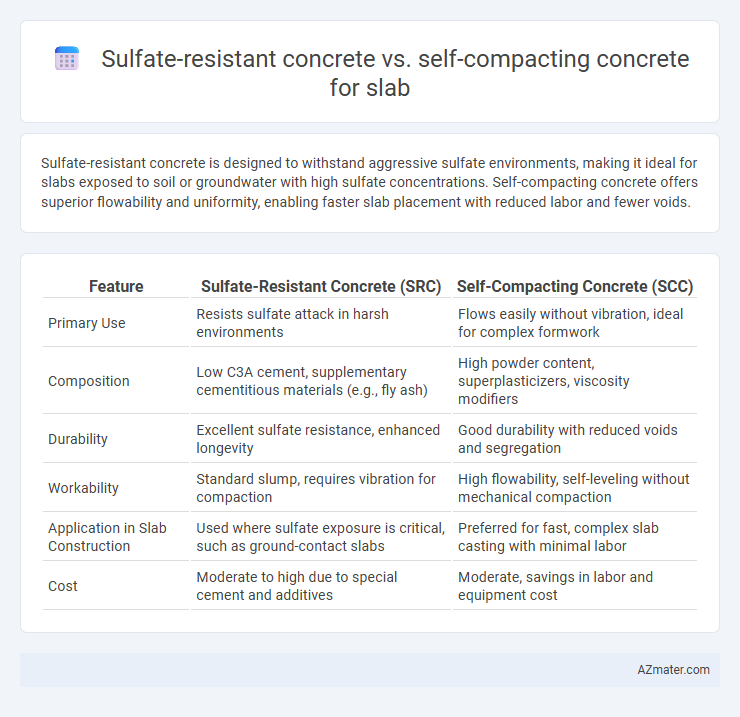Sulfate-resistant concrete is designed to withstand aggressive sulfate environments, making it ideal for slabs exposed to soil or groundwater with high sulfate concentrations. Self-compacting concrete offers superior flowability and uniformity, enabling faster slab placement with reduced labor and fewer voids.
Table of Comparison
| Feature | Sulfate-Resistant Concrete (SRC) | Self-Compacting Concrete (SCC) |
|---|---|---|
| Primary Use | Resists sulfate attack in harsh environments | Flows easily without vibration, ideal for complex formwork |
| Composition | Low C3A cement, supplementary cementitious materials (e.g., fly ash) | High powder content, superplasticizers, viscosity modifiers |
| Durability | Excellent sulfate resistance, enhanced longevity | Good durability with reduced voids and segregation |
| Workability | Standard slump, requires vibration for compaction | High flowability, self-leveling without mechanical compaction |
| Application in Slab Construction | Used where sulfate exposure is critical, such as ground-contact slabs | Preferred for fast, complex slab casting with minimal labor |
| Cost | Moderate to high due to special cement and additives | Moderate, savings in labor and equipment cost |
Introduction to Sulfate-Resistant and Self-Compacting Concrete
Sulfate-resistant concrete is specifically formulated to withstand exposure to sulfate-rich environments, utilizing low C3A cement to prevent chemical deterioration in slabs subjected to aggressive soils or groundwater. Self-compacting concrete (SCC) is designed to flow effortlessly into complex formworks without mechanical vibration, enhancing slab uniformity and reducing labor. Both types address distinct challenges in slab construction: sulfate resistance ensures durability against chemical attack, while SCC improves placement efficiency and surface finish quality.
Importance of Concrete Selection for Slab Construction
Choosing sulfate-resistant concrete for slab construction is crucial in environments exposed to sulfate attacks, as it prevents chemical deterioration and extends the slab's durability. Self-compacting concrete enhances slab quality by improving workability and ensuring uniform compaction without vibration, reducing voids and increasing structural integrity. Selecting the appropriate concrete type directly impacts the slab's lifespan, performance under environmental stress, and maintenance costs.
Properties of Sulfate-Resistant Concrete
Sulfate-resistant concrete exhibits enhanced durability due to its low C3A content, effectively resisting sulfate attack in aggressive environments, making it ideal for slabs exposed to sulfate-rich soils or groundwater. Its dense microstructure, achieved through the use of supplementary cementitious materials like fly ash or slag, reduces permeability and improves chemical resistance. This specialized concrete ensures long-term performance and structural integrity in sulfate-prone conditions compared to conventional or self-compacting concrete.
Key Characteristics of Self-Compacting Concrete
Self-compacting concrete (SCC) is characterized by its high flowability, allowing it to fill complex formwork and encapsulate reinforcement without the need for mechanical vibration. The mixture typically includes superplasticizers and viscosity-modifying agents to maintain stability and prevent segregation during placement. SCC offers enhanced surface finish, reduced labor costs, and improved durability compared to traditional concrete, making it ideal for slabs with intricate reinforcement layouts where sulfate-resistant properties may not be the primary concern.
Performance in Aggressive Sulfate Environments
Sulfate-resistant concrete offers enhanced durability by incorporating low C3A cement, reducing chemical reactions with sulfates in aggressive environments, thereby preventing expansion and cracking. Self-compacting concrete, while providing superior workability and uniformity for slabs, requires sulfate-resistant cement or additives to ensure long-term performance in sulfate-rich soils. For slabs exposed to aggressive sulfate conditions, combining self-compacting properties with sulfate-resistant cement optimizes both placement efficiency and resistance to sulfate attack.
Workability and Placement Efficiency
Sulfate-resistant concrete offers enhanced durability in aggressive environments but typically requires lower water content and stronger admixtures, resulting in moderate workability compared to self-compacting concrete (SCC). SCC excels in workability due to its high flowability and ability to fill formwork under its own weight without vibration, significantly improving placement efficiency for slabs. The superior fluidity of SCC reduces labor and equipment needs, making it ideal for complex slab geometries where rapid, uniform compaction is critical.
Durability Comparison: Longevity and Maintenance
Sulfate-resistant concrete offers enhanced durability in sulfate-rich environments by preventing chemical attacks that cause deterioration, significantly extending slab longevity with minimal maintenance. Self-compacting concrete, while providing superior workability and uniform compaction, may require additional protective measures in aggressive sulfate conditions to maintain durability. The choice depends on environmental exposure; sulfate-resistant concrete ensures longer service life and lower maintenance in corrosive settings, whereas self-compacting concrete excels in ease of placement with moderate durability.
Strength and Structural Performance in Slabs
Sulfate-resistant concrete offers enhanced durability and strength in slabs exposed to aggressive sulfate environments, preventing deterioration and maintaining structural integrity over time. Self-compacting concrete ensures uniform filling and consolidation in slab construction, resulting in superior surface finish, reduced voids, and consistent compressive strength. While sulfate-resistant concrete excels in chemical resistance and long-term strength retention, self-compacting concrete improves structural performance through better workability and homogeneity in slab applications.
Cost Implications and Economic Considerations
Sulfate-resistant concrete typically incurs higher material costs due to specialized cement and additives, making initial investment more expensive compared to self-compacting concrete, which reduces labor and equipment expenses through easier placement and faster construction cycles. Self-compacting concrete enhances cost efficiency by minimizing formwork vibrations and improving overall productivity, thus lowering indirect project costs despite slightly higher material prices than conventional mixes. Economic considerations must weigh long-term durability benefits of sulfate-resistant concrete in aggressive environments against the immediate savings and time efficiency offered by self-compacting concrete for slab applications.
Best Use Cases: Choosing the Right Concrete for Slab Applications
Sulfate-resistant concrete is ideal for slabs exposed to aggressive sulfate-rich environments, such as sewage treatment plants or marine structures, due to its enhanced durability against chemical attacks. Self-compacting concrete excels in complex slab forms requiring superior flowability and uniform consolidation without vibration, making it suitable for densely reinforced or architecturally intricate slabs. Selecting the appropriate concrete depends on environmental exposure and structural complexity, ensuring longevity and structural integrity in slab applications.

Infographic: Sulfate-resistant concrete vs Self-compacting concrete for Slab
 azmater.com
azmater.com